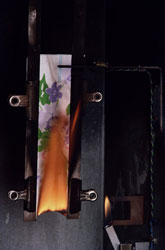Fireproof flexible textile structures
The protection of fabrics against fire is of paramount importance for many professionals, particularly firemen. Intumescent textiles are designed to perform under critical conditions, where temperatures are extremely high. The intumescence concept provides a balance between the fire properties and the level of additives in the material. When heated, special layers are developed on the surface in order to protect the underlying material from the action of flame or heat flux. These coating formulations are optimised in terms of physico-chemical properties in order to limit both heat transfer from, and mass transfer to the heat source. In this way the underlying material is protected. Based on the intumescence concept, the NEREFITE project focused on recent developments of flame retardant polymers to enhance fire safety in textile fabrics. In line with environmental regulations against use of halogenated fire retardants, researchers developed specialised non-halogeneous formulations for exploitation of polypropylene polymer in fibres' applications. These polypropylene-based formulations are capable of promoting fire retardant properties, while maintaining polymer mechanical properties of the fibre. For this purpose a wide range of additives were studied and analysed and at the same time the most favourable processing conditions were set. The novel formulations have also been optimised for achieving maximum performance both at lab and pilot scales. Apart from the textile sector, the new formulations may also be well exploited by other sectors where fire safety is critical. These include the automotive, construction and building materials as well as furnishing industries.







